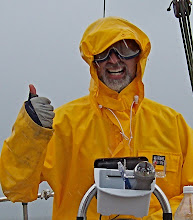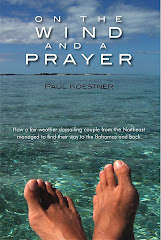
Confused Seas
To sail to an island in the Atlantic I’d only visited once or twice, the easy way, by cheating, by ferry. Always with “other chicks”, as my wife likes to put it. The next time around I planned to do it right, with the chick I’d pledged the rest of my life to, on our very own sailboat. That had been my Big Idea, until Deb had gone and hijacked me on that same boat, to the Bahamas.
Now there was a nice little trip. I wrote about it, too, in a book you can purchase for a reasonable sum. Just punch in “windandaprayer” on your favorite search engine and enjoy the journey. My favorite search engine happens to be a Morgan 34 sloop named Laura Lynn, but now I’m just playing with words.
Despite the successful completion of that somewhat more ambitious nautical endeavor, there was left in me a sense that a certain personal goal had gone unfulfilled. But there was still time on my biological clock, family cardiac history notwithstanding. Weren’t we as often as not referred to as “the kids” (Isn’t that cute? I was fifty at the time) on the aforementioned journey? Had we not proven we could negotiate a year away from home, combing an entire continental seaboard if we put our minds to it? How hard could it be then, to reach a well-scoped island off the tip of Montauk?
It was a laughable distance now, in our seasoned estimate. A hop, skip, and Long Island jump offshore. We’d be crying “Land ho!” before the coast of Connecticut was spitting distance off our stern. Still I managed, as is my custom, to worry the pants off the thing. Once the time frame had been established for late July, with four days allotted each for the leaving from and returning to our home harbor of Manhasset Bay, with three days set aside for island tomfoolery, I started plotting for disaster.
We could’ve turned around in fear and loathing any time we wanted. The Long Island Sound is generously pocked on both shores with viable avenues of escape, if you don’t read into the fine print.
It was a laughable distance now, in our seasoned estimate. A hop, skip, and Long Island jump offshore. We’d be crying “Land ho!” before the coast of Connecticut was spitting distance off our stern. Still I managed, as is my custom, to worry the pants off the thing. Once the time frame had been established for late July, with four days allotted each for the leaving from and returning to our home harbor of Manhasset Bay, with three days set aside for island tomfoolery, I started plotting for disaster.
We could’ve turned around in fear and loathing any time we wanted. The Long Island Sound is generously pocked on both shores with viable avenues of escape, if you don’t read into the fine print.
But see, I like to read into the fine print. Boat people have prospered for generations around harbors I might write off as untenable due to excess pollen counts. I knew from sad experience that you can dismiss any navigable stretch of water, given the proper irrational fear born of unfamiliarity. I prefer to look at every listed anchorage as a potential opportunity to sink our boat.
This is where Deb always steps in. With thousands of miles under her luscious keel, my mate is still unable to reliably tie a clove hitch. If you have issues with that confession, Mr. Burr, I’ll gladly challenge you to a duel. And I’ll give you some insider information: I can’t hit the broad side of a boat shed with a skeet choke.
The thing is, despite Deb’s refusal to retain any nautical lesson proffered thus far, she makes magical things happen for her tentative crew. I don’t care if you can weave storm sails from the spider webs salvaged from your shrouds, you’re going nowhere without the right mindset. Deb has positive attitude in abundance, and no amount of ignorance on a subject will dissuade her from tackling a challenge head on. So we were going to go to Block Island, on a schedule that worked for her.
This is where Deb always steps in. With thousands of miles under her luscious keel, my mate is still unable to reliably tie a clove hitch. If you have issues with that confession, Mr. Burr, I’ll gladly challenge you to a duel. And I’ll give you some insider information: I can’t hit the broad side of a boat shed with a skeet choke.
The thing is, despite Deb’s refusal to retain any nautical lesson proffered thus far, she makes magical things happen for her tentative crew. I don’t care if you can weave storm sails from the spider webs salvaged from your shrouds, you’re going nowhere without the right mindset. Deb has positive attitude in abundance, and no amount of ignorance on a subject will dissuade her from tackling a challenge head on. So we were going to go to Block Island, on a schedule that worked for her.
I’m a freelancer, so I can flip off any work I want to. Deb has a real job, and she wants a real vacation, so I got the boat and myself ready, as per her itinerary. We were loaded down with more stuff than we’d taken on our sabbatical to the Bahamas. I’d listed what we’d forgotten on that trip and made sure we didn’t forget it this time. I packed a radar reflector, just to spite myself. It’d been somehow waylaid in the garage during our last trip, but it wouldn’t be this time, just in case we ran into pea soup at the onset of a lazy mid-summer’s morning and were still stupid enough to raise anchor. I took a sextant too, a frivolous gift from my brother, on the off chance we were boarded by Rhode Island pirates demanding any stuff I didn't know how to use, or my life. We should’ve packed more Oreos instead.
But I did pack everything we would need. Everything but the kitchen sink. Check that. Everything but the kitchen sink, and my wallet.

It is a sad commentary for a survival-oriented guy like myself, that he can be reduced to tears when he realizes that his Stop & Shop discount card has been left ashore. The fact is, most of my swagger for this trip was founded on media-induced complacency. If I’d actually left home something important, I’d recited, we could always go into town and buy it with a credit card, while the accompanying reminiscences would be provided, gratis.
So there I was, all gussied up in the saloon, having radioed from our mooring in Northport, New York (our first day’s stop) for a complimentary launch ride into town. I was now frantically searching for the fanny pack that announces to the world that I am an Olympic-Class Dweeb. The cold sweats that overtook me came near in intensity to the bout I'd had somewhere along the Carolinas when we’d dragged anchor in the middle of the night during a horrific squall, while stark naked. Read all about it in the aforementioned book. Oh yeah, baby.
I was fit to be tied. Or, if you ask Deb, I was fit to be tossed overboard. I could not shake my wretched mistake. We had just enough chump change between us to scrounge a meal in this otherwise completely quaint coastal destination (the food tasted bitter, the town reeked of sour sweat, and the sounds from the local band shell seemed funneled from the lowest levels of Dante’s Inferno), and to tip the launch chick to get back to our boat. Yes, I said launch chick. My own chick had rightfully deserted me in spirit, and I was on my own. Survival instinct was in play. I was, in the parlance of your extreme sailor, a real pill.
But I did pack everything we would need. Everything but the kitchen sink. Check that. Everything but the kitchen sink, and my wallet.

This is wonderful. I wonder if I've forgotten anything.
So there I was, all gussied up in the saloon, having radioed from our mooring in Northport, New York (our first day’s stop) for a complimentary launch ride into town. I was now frantically searching for the fanny pack that announces to the world that I am an Olympic-Class Dweeb. The cold sweats that overtook me came near in intensity to the bout I'd had somewhere along the Carolinas when we’d dragged anchor in the middle of the night during a horrific squall, while stark naked. Read all about it in the aforementioned book. Oh yeah, baby.
I was fit to be tied. Or, if you ask Deb, I was fit to be tossed overboard. I could not shake my wretched mistake. We had just enough chump change between us to scrounge a meal in this otherwise completely quaint coastal destination (the food tasted bitter, the town reeked of sour sweat, and the sounds from the local band shell seemed funneled from the lowest levels of Dante’s Inferno), and to tip the launch chick to get back to our boat. Yes, I said launch chick. My own chick had rightfully deserted me in spirit, and I was on my own. Survival instinct was in play. I was, in the parlance of your extreme sailor, a real pill.
We considered turning the boat around right then and there, or maybe taking a taxi home, or possibly a commuter train. Each solution would have proven costly to our collective wallet (which we didn’t have) and/or time (which I weigh heavily in the forward direction). We finally called Deb’s sister Laura (the inspiration for our boat's moniker and much else in life). She dispatched her husband Vincent, who retrieved the wayward fanny pack from the back seat of our garaged sedan, where I’d left it while searching for important stuff to stow onboard. How do you spell “Loser”?
Laur and Vin drove to Northport the next day to make the drop-off, taking a half hour or so to do in a car what it had taken us the lion's share of a day to accomplish by sailboat. We treated them to dinner for their trouble. The food was delectable, and the company unsurpassed. Afterward, the town smelled of lilacs, and a celestial choir was in perfect pitch at the bandshell. Try never to be in a hurry when traveling by boat. I mean never.
We were again independent, as is a newly bandaged child once he remounts his trike, to set off in search of new potholes to challenge. I’m not sure what I learned from the incident. Perhaps as little as nothing, but maybe this: Attitude is Everything. But then I already knew that.
Because Deb has limitless capacity for forgiveness, we were on our way east the next morning, full of nothing but anticipation. Women rock, don’t they? Thank the heavens, because this story is nothing but euphoric from here on in. Which makes it just about over, doesn’t it?
Each morning was ripe with promise, each evening a celebration of the day’s gifts. Block Island was a gem: raucous, primal, sublime. We were reminded yet again what a great, grand thing a small boat can do for the soul.












